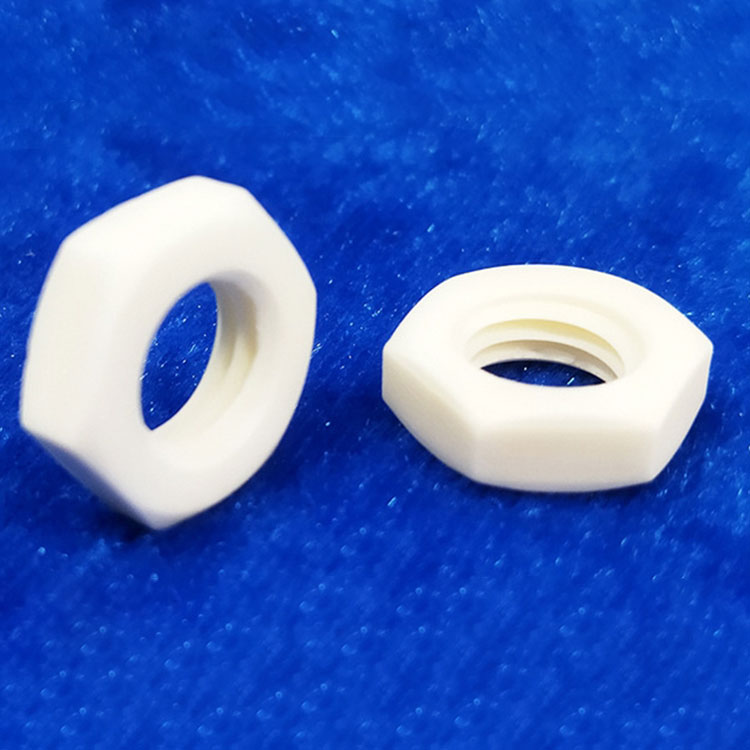High hardness and high wear resistance of alumina ceramics
2025-06-23
Alumina ceramics, also known as aluminum oxide (Al₂O₃), are widely recognized for their exceptional hardness and outstanding wear resistance. These properties make alumina ceramics indispensable in a variety of industrial applications, ranging from mechanical engineering to electronics and biomedical devices. The key to their performance lies in the material's inherent structure, chemical composition, and the processes involved in their manufacture.
1. Composition and Structure of Alumina Ceramics
Alumina ceramics are primarily composed of aluminum oxide, a compound that naturally occurs in minerals like bauxite. The material is known for its crystalline structure, which is highly ordered at the atomic level. This crystalline arrangement contributes to the material's remarkable hardness. The typical hardness of alumina ranges from 9 to 9.5 on the Mohs scale, which is second only to diamond in terms of common materials.
In addition to its crystalline structure, alumina ceramics may contain different additives or doping agents to enhance specific properties. For instance, small amounts of other oxides such as magnesium oxide or yttrium oxide are sometimes incorporated to improve sintering and grain growth, leading to better wear resistance.
2. High Hardness of Alumina Ceramics
The high hardness of alumina ceramics is one of its most significant features. Hardness refers to a material's ability to resist surface deformation, particularly from indentation. Alumina's hardness is attributed to its tight atomic bonding, where the aluminum ions are surrounded by oxygen ions in a strong, covalent bond. This bond prevents the material from being easily deformed, even under high pressure or friction.
Because of their hardness, alumina ceramics are often used in applications where the material is exposed to abrasive conditions. For example, in industries such as mining, steel production, and chemical processing, alumina components can withstand wear and tear from interacting with rough or abrasive materials. This makes them ideal for applications like wear plates, cutting tools, and grinding wheels.
3. Wear Resistance of Alumina Ceramics
Wear resistance refers to a material's ability to resist degradation when subjected to friction or mechanical stress. Alumina ceramics exhibit excellent wear resistance, which is one of the reasons they are used extensively in industries requiring durable materials.
The wear resistance of alumina is attributed to its high hardness, as harder materials tend to wear more slowly. Furthermore, the smooth, dense surface of alumina ceramics reduces the likelihood of surface cracking and pitting, which are common causes of wear in many materials. The lack of porosity in high-purity alumina also contributes to its wear resistance. Porous materials are more susceptible to wear because the surface is less continuous, allowing cracks to propagate more easily.
Applications where wear resistance is essential include components like bearings, seals, pumps, and valves, which are subject to constant friction and pressure. In these applications, alumina’s resistance to abrasion ensures a longer lifespan, reduces maintenance costs, and improves overall system reliability.

4. Advantages in Industrial Applications
The combination of high hardness and high wear resistance makes alumina ceramics ideal for several industrial uses:
Abrasive Materials: Alumina ceramics are used in products like grinding wheels, cutting tools, and sandpapers due to their high hardness.
Automotive and Aerospace: Components such as piston rings, brake pads, and nozzles often use alumina ceramics because of their ability to endure harsh conditions.
Biomedical Applications: In orthopedic implants, such as hip and knee joints, alumina ceramics are employed for their hardness, wear resistance, and biocompatibility.
Electronics: Alumina is commonly used as a substrate material in electronic components due to its insulating properties combined with its wear resistance, making it ideal for harsh electrical environments.
5. Challenges and Future Developments
While alumina ceramics are highly valued for their hardness and wear resistance, there are some challenges. For instance, although they perform well under compressive loads, alumina ceramics are brittle and prone to fracture under tensile stress. This limits their use in some applications where high impact resistance is required.
To overcome these limitations, researchers are exploring ways to enhance the toughness of alumina ceramics. One such method involves the introduction of toughening agents like zirconia, which can improve the material's ability to withstand impact without cracking. Another approach is to develop alumina composites, combining alumina with other materials to optimize the balance between hardness, toughness, and wear resistance.
6. Conclusion
Alumina ceramics stand out as a material with extraordinary hardness and wear resistance. These properties make alumina ceramics vital for a wide range of applications, from industrial machinery to medical devices. Their unique combination of attributes results from a strong atomic structure and a dense, smooth surface that resists wear under harsh conditions. As research continues to improve the toughness of alumina ceramics, their applications are likely to expand, offering even greater performance in demanding environments.
As a professional manufacturer and supplier, we provide high-quality products. If you are interested in our products or have any questions, please feel free to contact us.


